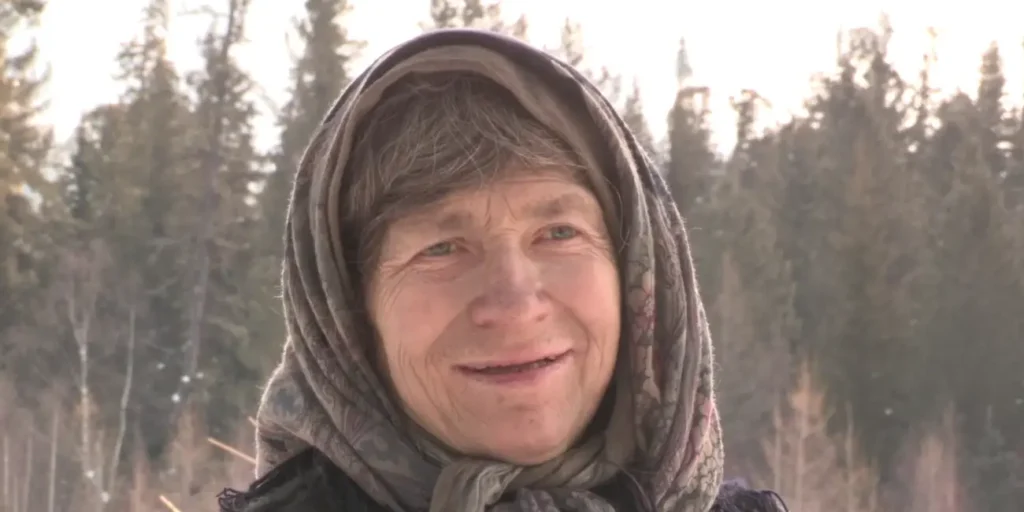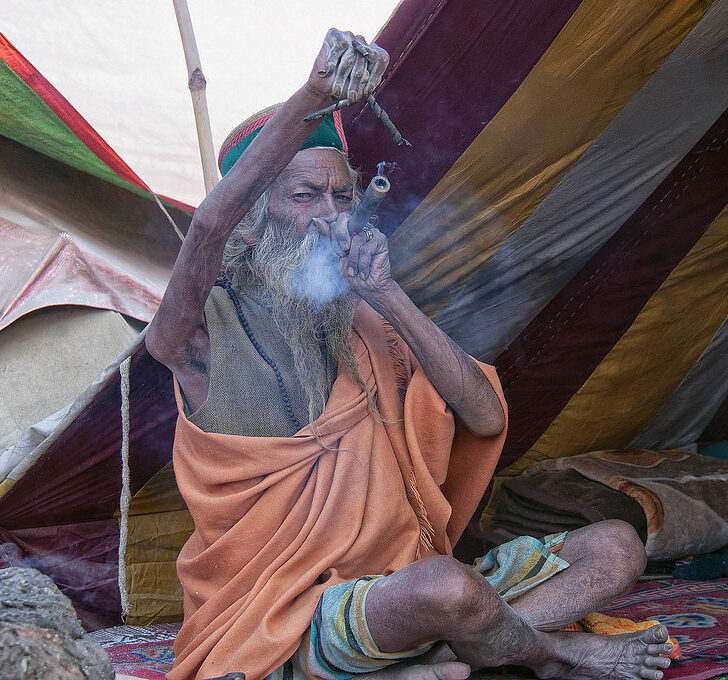In the summer of 1978, a helicopter pilot was sent deep into the Russian wilderness, close to the Mongolian border. The task was to find a safe place to land a team of geologists surveying the vast untouched landscape in hopes of striking iron ore.
As the pilot hovered just above the trees, close to the basin of the Abakan River in Southern Siberia, he noticed something in the distance: a hut.


The pilot was astounded, the nearest town or village was 150 miles away and as far as records indicated, nobody lived in this region of the forest.
The landscape was harsh and inhospitable, with thick lines of trees and mountains. The geologists on board were excited when they overheard the pilot and they decided to land and check it out.
Over the next few hours, the group trekked up a large mountainside to get to the hut. After trekking for miles in an endless forest, they assumed they had collectively imagined it, but shortly after reaching the mountain’s peak, they found it.
The hut showed signs of life; there was a garden outside with mild vegetation, and murmurs could be heard inside.
Upon approach, they found a one-roomed cabin made from wood and other sourced materials. The room itself stank of must and rotting foliage and was dimly lit by a fire that sent soot cascading up the walls.
The floor was made entirely from potato peel and pine-nut shells, a far cry from the grey khrushchevka’s many in nearby towns called home.
As their eyes scanned the hut again, they realized there were people inside, five in fact. From the dimly lit corner, an old man with a grey beard spoke, “Well, since you have travelled this far, you might as well come in.”
The two groups cautiously approached each other, with the geologists introducing themselves. The man spoke in turn, introducing himself as Karp Lykov.
He explained that he shared the hut with his four children, Savin, Natalia, Dmitriy and Agafia. In the background, the scientists heard a female voice, chanting and praying, saying “this is for our sins”.
Whilst Karp was more forthcoming, the others inside were far more hesitant to approach the scientists. Even whilst their father chatted, the women were hysterical.

Over the coming days, the scientists continued visiting the Lykovs to build trust. They had no idea how long the family had been there and didn’t want to put their backs against the wall and possibly spur a violent response.
During one particular visit, Karp opened up about his background and how he and his family had come to be in an isolated cabin in the Siberian woods.
The Old Believers
Russian Orthodoxy is an offshoot of Christianity created in the Rus many centuries ago. Through time, customs and culture moulded the Russian Orthodox Church into what it is today.
In the 17th Century, the Russian Orthodox Church changed some of its rituals and practices to mirror those of the Greek Orthodox Church. While most members accepted this change, a new group sprouted.
They called themselves the ‘Old Believers’ and refused to adopt these ‘new ways’. They were content with their practices, believing these were the ‘real ways’.
The Old Believers began to isolate themselves from the main worshippers as they were often beaten, imprisoned and tortured. The Church tried eradicating the group, but some fled to neighbouring countries.
In 1917 the Russian landscape saw a major change when the Bolsheviks rose up and started a revolution. Now, the Old Believers were under more threat than ever.
The Communist Party wanted everyone to fall in line with the same beliefs and worship under the same banner. Karp Lykov and his family, Akulina, Savin and Natalia, refused.
Bolshevik Officers regularly took away Old Believers to face a fate worse than death. In 1936, Karp Lykov witnessed this brutality first-hand when the Bolsheviks killed his brother.
Fearing for his and his family’s safety, Karp woke them in the middle of the night, swept their belongings into bags and fled to the safety of the Siberian wilderness.
The family walked for many days and nights until they found a spot atop a mountain near the Abakan River. Karp and Akulina set about creating a makeshift hut that would see alterations and additions throughout the years.
This dinghy, single-room hut would be their home for the next 40 years. They were completely isolated from the outside world, just as Karp wanted.
Survival In The Tundra
Surviving the Siberian wilderness with two young children was challenging, to say the least. They had brought pots, pans and kettles with them and survived on whatever they could forage. Their meals mainly consisted of potatoes, rye, berries and the occasional small animal.
When their shoes and clothes wore out, the family used hemp and birch bark to make new ones. These were far less effective at keeping the cold and wet out, but it was all they had.
Over time, their equipment also began to give out. Akulina spent days creating new pots from dried-up bark and whatever other natural materials she found.
Unfortunately, the family were not able to find spare metal to make new pots, so they had no way to cook food. A small fire roared in the hut, and its only purpose was to keep them warm.
Life for the Lykovs was difficult, but Karp and Akulina found some semblance of joy when they welcomed Dmitry and Agafia into the world. The babies were swaddled in hemp cloth and wore little birch bark shoes.
Karp spent his time teaching his children how to find clean water, chop down trees for firewood, and repair the hut.
In 1961, the Lykovs faced a harrowing tragedy when, in June, significant snowfall killed all of the crops they had planted. Their potato crop was the worst affected, meaning the family faced a harsh winter of starvation.
The landscape was working against them, and that is when Akulina made a decision. Instead of seeing her beloved children suffer, she opted to starve to death so they could eat.
These details were relayed to the geologists, who looked on in horror. They offered to help the Lykovs by taking them to a city where they could find an apartment and jobs, but they refused.
The children had no idea about the outside world, aside from the fact that people lived in ‘cramped’ conditions in large settlements.
Karp was the most vocal; he had spent over 40 years isolated from the world and intended to stay in his cabin until his death. The family had no idea of the Second World War that had ravaged Europe or that two nuclear bombs had been dropped on Japan.
As the family refused to move, the geologists gifted them salt, knives, forks, grain, pens, paper and a torch.
Life After Discovery
The geologists returned to their objective and continued visiting their newfound friends. Despite multiple offers, the Lykovs remained in their dirt cabin, which remained close to below 0 degrees Celsius.
Sadly, in 1981, Savin, Natalia, and Dmitry passed away within days of each other. Karp and Agafia lived peacefully in the cabin until Karp died in 1988.
Following her father’s death, Agafia stayed at the family cabin, tending to her goats and crops. Agafia would make five rare visits to the surrounding cities to get medical care or to visit family members, but she would always return to what is now known as the Lykov territory.

The story of the Lykovs received widespread attention in the Russian media, and thanks to the internet, it has spread around the world.
In 2016, Agafia had to be airlifted from her cabin to the hospital to receive medical treatment. While hospitalized, Russian authorities tried to make her move to a city, but she refused. After being discharged, Agafia ordered authorities to take her back to the Siberian wilderness.
As of 2024, 80-year-old Agafia Lykov still lives in the cabin her father built in 1936 after fleeing persecution. Her tale is bizarre and somewhat unbelievable to those living in modern cities and towns.
When asked what she thought of modern settlements, Agafia commented that there were ‘too many people’ and ‘too many cars’. She added that it was hard to breathe because of all the toxins in the air.
Agafia will likely remain at the cabin until it is her time to leave the world.
Sources
https://allthatsinteresting.com/lykov-family
https://www.vice.com/en/article/dp4mzj/meet-the-last-lykov-000001-v20n4












Leave a comment